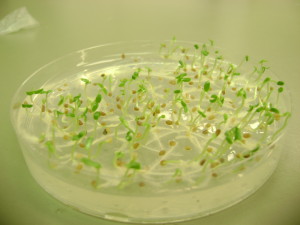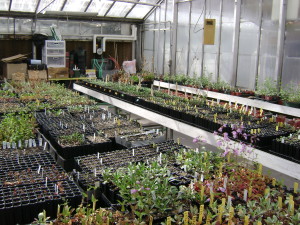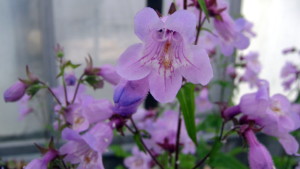A few years back I had a job as a seed germinator. I had the awesome responsibility of convincing Penstemon seeds that they should be growing in our greenhouse. I didn’t know what a Penstemon was at the time and only had the vaguest notion about how seeds grow having watched many a bean grow in a windowsill Dixie cup over the years. But work is work and it pays for granola bars so…yup.
Penstemon are kind of like the 151st Pokémon. Okay, actually they have nothing to do with Pokémon. It’s a genus of wildflower very common in the United States. Also known as Beardtongue, there are something like 260+ species of Penstemon growing in just about every climate type on the continent. They are small plants generally but come in a fantastic array of colors and varieties. I see them often in the foothills of the Wasatch (firecracker Penstemon) and sometimes in the higher cooler mountain valleys (Palmer’s Penstemon). I’ve seen them at the Grand Canyon, Yosemite, Grand Tetons, and covering the meadows of the high Uinta Mountains.
Cool thing about seeds that grow in cold places: they have to know when spring is coming. If there is a warm December and all the seeds germinate only to get killed by the January snows then the species would die. So the seeds, particularly in the high mountains, have developed something called stratification. Stratification is a way the seeds are built to delay germination until weather conditions are suitable. Usually it’s like a waxy coating that takes a certain amount of water/freezing or scarification to remove. Sometimes we had to refrigerate the seeds at near freezing temperatures to break them free. The higher the elevation, the longer the winter, the longer we had to refrigerate them. Sometimes we would hit them with a dilute mixture of sulfuric acid to remove the waxy coating (dangerous because just a little too much and you can kill the seed (and it smells really bad)). As a final step we would soak them for 24 hours in a Gibberellic acid solution. This simulates a plant hormone that tells the seed spring is here and it’s time to grow.
With the seeds woken up they then needed a germination bed. We used agar coated petri dishes, just like you would use to grow bacteria in a lab. We would spread 100 seeds on a petri dish (that had first been baked in UV light to kill any fungus) and seal them in with paraffin wax. The agar would provide some basic nutrients as well as moisture. In two weeks or so the little plants would start to emerge, shooting little radical roots into the soft clear gel. The big threat at this stage was fungus. No matter how carefully we cleaned the petri dishes and washed the seeds and sterilized all our tools fungus would inevitably invade the dish. It became a race between seedlings and fungus. The Penstemons had to get their first pair of leaves before the fungus killed them so we could transplant them into soil. If you left on the weekend you would often come back to the lab to find a fuzzy black death where once your new crop of Penstemon’s had been. You then whip out the tweezers and pull out any seedlings that might have a chance.
The small plants are removed from the agar (hopefully clear of infection) and placed in small soil-filled trays, with each compartment holding about 1 cubic centimeter of soil. They have holes in the bottom so you can place the whole tray in a puddle and the water can soak up into the soil. Outside of their sealed petri dish drying out becomes a real problem. They have to be watered roughly every other day or death will come. With leaves and stems measured in the millimeters they can’t afford to wilt, not even once. Too many times I came back to the lab to find the soil dry and the water starved plants hanging limply in their cube trays.
If they make it past the cube trays we would move them into larger containers and move them into the greenhouse. In the greenhouse they get slightly less controlled growing conditions, more soil, real sunlight, and an opportunity to really take off. If they do well and continue to survive the big plant world they may even flower in the greenhouse and produce a new generation of seeds.
I skipped the part about why a genetics professor would want to grow thousands of seedlings (GMOs) and I’ll also skip giving the actual mortality rate among the seeds. You can imagine that very few of the seeds survive to produce a flower with seeds of its own. But there is a reason I tell the story.
3 And he spake many things unto them in parables, saying, Behold, a sower went forth to sow;
4 And when he sowed, some seeds fell by the way side, and the fowls came and devoured them up:
5 Some fell upon stony places, where they had not much earth: and forthwith they sprung up, because they had no deepness of earth:
6 And when the sun was up, they were scorched; and because they had no root, they withered away.
7 And some fell among thorns; and the thorns sprung up, and choked them:
8 But other fell into good ground, and brought forth fruit, some an hundredfold, some sixtyfold, some thirtyfold.
9 Who hath ears to hear, let him hear.
Some seeds never germinate. They remain stratified and produce not even a wisp of green leaf or pale root.
Some seeds dry out. They don’t get watered often enough or the soil is too shallow to hold enough water to keep them alive.
Some seeds get attacked by fungus which steals their small store of nutrients, choking them out of life.
Some seeds make it to the greenhouse and bring forth flowers, some a few and some many.
So aside from being a fascinating view into the world a plant propagation what does this have to do with you?
• Don’t sleep through opportunity. When spring comes, grow.
• Don’t get distracted by the “cares and riches and pleasures of the world.” You are a heart of a flower. Don’t give up your vitality to grow mold.
• Keep your roots deep in nourishing moisture. The sun will scorch, you will dehydrate. You must keep feeding the spirit or you will wilt.
• Every seed is capable of blooming. Not all of them do but you have to believe that you can. Believe in the mystery within you and trust the promise of the bloom. And the bloom is worth working for.
Happy flowering!








Recent Comments